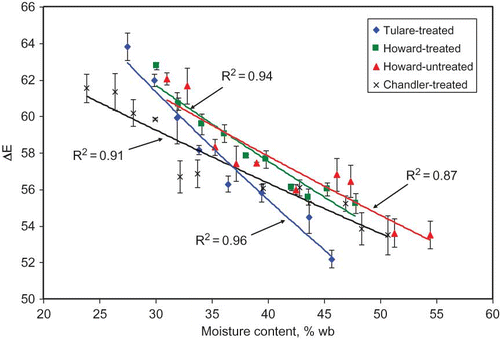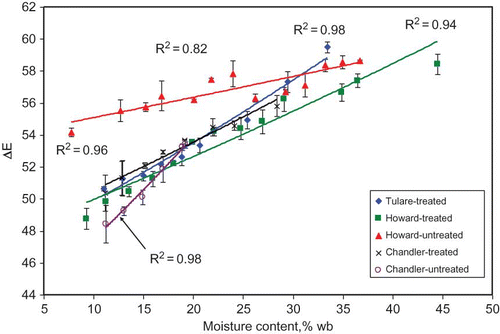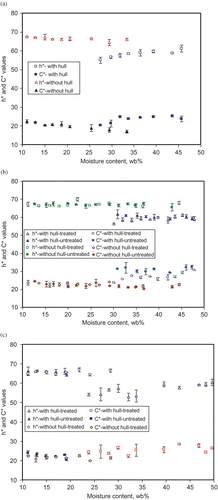Abstract
Characterizing the shell color of walnuts based on their moisture content at harvest can provide valuable information for performing walnut sorting before drying. The objective of this study was to investigate the relationship between the color characteristics of the shell of walnuts and their moisture content. Measurements were carried out for three walnut varieties, Tulare, Howard, and Chandler. The walnuts were sorted into two categories, namely with and without hulls at harvest. The Commission International de l'Esclairage's L*, a*, and b* color indices were measured to quantify the shell color after hull removal, and total color difference, hue angle (h*), and chroma (C*) values were calculated. The results indicated that the moisture content of walnuts with hulls at harvest was much higher than that of walnuts without hulls. The L* and ΔE values are highly correlated with moisture content and had different trends for walnuts with and without hulls. There was no clear relationship between other color characteristics and moisture content, although the a* values of walnuts with hulls were higher than those of walnuts without hulls. The results obtained revealed the potential of using the relationship between color indices of L* or ΔE and walnut shell moisture content to sort walnuts before drying, which is essential to avoid over-drying, increase drying capacity, reduce energy use, and obtain high quality walnut products.
INTRODUCTION
Walnuts are considered as healthy nuts with high nutrimental values and health benefits because of their high contents of oil, proteins, vitamins, fibers, minerals, and antioxidants. They are one of the most common tree nuts cultivated in California with almost 99% of the U.S. walnut production.[Citation1 Citation–Citation3] Consequently, the walnut industry consumes a considerable amount of energy for walnut handling, transportation, dehulling, and drying operations. There is a great need to improve such operations, especially drying, to reduce energy use and obtain high quality of walnut products.
At harvest, the moisture content (MC) of individual walnut varies significantly due to uneven maturation. Ethephone may be applied two weeks before harvesting time to walnuts to hasten the walnut harvest.[Citation3] It was also observed that during harvesting operation a high percentage, up to 40–50%, of harvested walnuts fall down to the orchard floor with adhering hulls especially for early-maturing varieties such as Tulare and Howard. The walnuts with adhering hulls have a higher MC than those without hulls regardless of the variety and harvest date.[Citation4] To preserve walnut kernel quality, it is important to pick up all walnuts with and without hulls from ground as rapidly as possible and to dry them to a desired 8% MC (w.b.).[Citation2,Citation5]
Commercial drying facilities typically commingle all nuts coming from farms with a wide range of initial MC and dry them as batches in bins using heated air at about 43°C for the entire time period. Some nuts that enter the dryer with high initial MC may end up to a MC of 10% or higher, which is above the safe storage moisture of 8%. Because of the variability of MC among individual walnuts, it is a common practice that the batch must be over-dried in order to ensure reaching the desired average MC and prevent from the quality problem caused by the walnuts with high MC. Tests by Thompson and Grant[Citation6] showed that an over-drying to 6% lot average MC resulted in 6 to 8 h of additional drying which represented 25–50% of total drying time. Thus over-drying caused low energy efficiency and revenue losses.
If walnuts are sorted into groups based on MC of individual walnuts before drying, the variation of individual walnuts in each group could be much reduced, which could result in minimized over-drying and under-drying. Moreover, based on our previous research the MC in shells had good relationship with the kernel MC and it was also higher.[Citation4] Therefore, it is possible to use elevated temperatures during the early stage of drying process to quickly remove part of shell moisture before kernel temperature reaches a maximum allowable value. This may not be feasible for the current process since the kernel of dry nuts may reach too high of a temperature, resulting in a quality problem.[Citation7,Citation8] Emerging and energy efficient drying technologies such as infrared may be used for the high temperature pre-drying.[Citation9 Citation Citation Citation Citation Citation–Citation15] If a reduced variability in MC is achieved through sorting before drying and a high temperature drying is applied in the early drying stage, it is expected that such measures could achieve increased drying capacity, reduced drying time and energy use, and maintain high quality of the products.[Citation16,Citation17]
Based on aforementioned facts and drying practices, there is a great need to sort individual walnuts based on their MC before the drying process. Color of agricultural products is an important property for design of sorting and grading equipment.[Citation18 Citation–Citation20] Establishing a relationship between color properties of walnut shell and MC could be the best way for sorting walnuts based on MC at harvest, which could mitigate introducing walnuts of uneven MCs into dryers and improve drying efficiency and dried product quality.
Color indices (L*, a*, b*) and their relationships with MC of individual nuts can be utilized to design sorting facilities. Color sorting technology has been in use commercially since 1930 and continues to show promising potentials in various applications in the food industry.[Citation20 Citation Citation–Citation23] The nut processing industry around the world also uses trichromatic sorting devices for identifying moldy grains, color defects, and impurities in the wavelength ranging from 400 to 1600 nm (http://www.buhlergroup.com). The most popular color space system for measuring color of agricultural products is the Commission International de l'Esclairage (CIE) color system which uses the L*, a*, and b* indices. The L*, a*, and b* indices have been related to the types and quantities of pigments present in agricultural products and have also been recommended to predict both chemical and quality changes in food products.[Citation24 Citation Citation–Citation27] The L*, a*, and b* indices have also been correlated with change of MC in some agricultural products.[Citation28,Citation29] A good correlation existed between yellow-blue (b*) color variable and the MC of peanuts.[Citation30]
Moisture-dependent color characteristics of walnuts should be useful to enable moisture based sorting of walnuts. The search of scientific literatures reveals an information gap on specific sorting criteria in walnut processing and drying operations. At the same time no reports are available regarding the color properties of walnut shells as correlated with individual nut MC. The information is vital for developing walnut sorting methods. Therefore, the objectives of this study were to (1) investigate the relationship between the color characteristics of walnut shells and MC of the individual nut for different varieties harvested at different times and conditions and (2) develop color-moisture regression models which can be used for walnut sorting during postharvest processing operations.
MATERIALS AND METHODS
Samples
Freshly harvested walnut varieties namely Tulare, Howard, and Chandler were obtained from Cilker Orchards (Dixon, CA, USA) during the 2009 harvest season and used throughout this study. Walnuts were shaken to the ground by mechanical tree shakers, raked into windows, and then picked up with sweepers and placed in trailers. The samples were collected from the trailers at the first harvest in September and second harvest in October of walnuts with and without ethephon treatment as listed in . The walnut samples were cleaned to remove trash and damaged, sunburned, and broken walnuts. The remaining nuts were divided into two categories namely with and without hulls. The category of nuts with hulls included nuts with intact, early-split, and partially-split hull. Before measuring color of the shells, the hulls of walnuts were manually removed. Then the walnuts without hulls were further mixed and 100 walnuts from each category were randomly selected to conduct the color and moisture measurements. The kernel in each nut was extracted using a manual cracker. The MCs of different components, including shell and kernel, for each nut were separately measured.
Table 1 Varieties and harvesting conditions for tests
MC Determination
Shells and kernels were separately placed in pre-weighed aluminum dishes and weighed using an electronic balance (Denver Instrument, Arvada Co., USA) with an accuracy of 0.01 g and dried in an air oven. Based on our preliminary tests, walnut samples attained a constant dry weight after 24 h at 100°C in the air oven. Therefore, these conditions were adopted throughout the experiments in order to dry walnuts to a constant dry weight. The samples (shell or kernel) were removed from the oven after 24 h, cooled in a desiccator, and then weighed again. The MC of the samples was determined based on the initial and final (dry) sample weights. All reported MCs are on wet-weight basis.
Shell Color Measurement
The color of walnut shells was measured using Minolta Chroma Meter (CR-200 reflectance colorimeter, Minolta, Japan). The instrument is a tristimulus colorimeter which measures color indices, specified by the CIE. The CIE L*, a*, and b* color indices were measured to determine the shell color of walnuts with and without hull. L* is the lightness component, which ranges from 0 to 100, and parameters a* (from green to red) and b* (from blue to yellow) are the two chromatic components which range from –120 to 120.[Citation31] Also, the total color difference (ΔE), a single value which takes into account the differences between the L*, a*, and b* of the sample and standard was calculated from the following EquationEq. (1):
Regression Models
The Sigma Stat software (version 2.0, Jandel Corporation, San Rafael, CA) was used to develop regression models between shell MCs versus L* and ΔE values under the tested conditions. These models were developed to facilitate the accurate prediction of L* and ΔE values versus shell MC.
RESULTS AND DISCUSSION
Moisture Variability Among Walnuts
The obtained results revealed that there was a huge variability in MC among individual walnuts at harvest (). The MC of walnuts with hulls at harvest was much higher than that of walnuts without hulls. For example, the MC of Tulare at first and second harvest ranged from 28.23 to 51.82% and from 24.82 to 43.04% for nuts with hull, and from 9.70 to 35.44% and from 7.17 to 31.32% for nuts without hull. This trend was observed for all tested varieties and it was consistent with previous findings.[Citation4] The walnuts with hulls had an average MC of 34.47% compared to 15.15% for walnuts without hulls. These results confirmed the need to sort walnuts based on individual MCs before drying. If the walnuts are sorted into different groups with a similar MC and then dried separately, the required drying time for each group should be significantly reduced and over-drying and under-drying can be minimized. The related drying research results will be reported in another publication.
Table 2 Maximum and minimum values of MC of whole walnut with and without hull at harvest (%w.b.)
Color Indices of Walnut Shells
Color parameter L*
The L* values of walnut shells, with and without hulls, were dependent on MC and showed different trends. They decreased and increased with increase in MC for walnuts without and with hulls, respectively, for all three varieties. For example, the L* value decreased from 51.1 to 40.2 when the MC increased from 10.35 to 33.41% for walnuts without hulls and increased from 36.3 to 50.7 when the MC increased from 26.8% to 46.30% for walnuts with hulls for Tulare at first harvest (). A similar trend was observed for Tulare at second harvest.
Figure 1 Relationship between color indices and MC for treated Tulare walnuts with and without hulls at first harvest. (Color figure available online.)
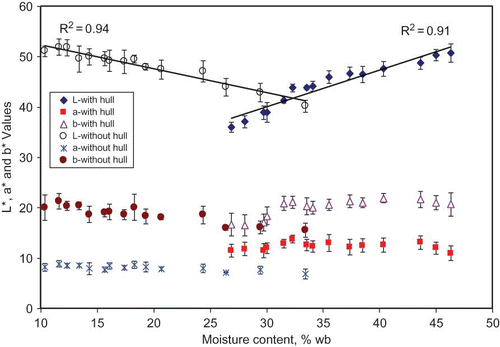
For the Howard variety, the L* value of treated walnuts without hulls decreased from 55.5 to 43.2 when the MC increased from 8.81 to 44.48%, comparing to an increase from 38.8 to 50.8 when the MC increased from 29.63 to 47.78% for treated walnuts with hulls at second harvest (). For walnuts not using ethphone treatment, the L* value also lowered from 48.3 to 42.1 when the MC changed from 7.27 to 43.64% for the samples without hulls and increased from 43.0 to 53.9 when increasing MC from 30.13 to 54.43% for samples with hulls at second harvest (). A similar trend was observed for Howard at first harvest. Similarly, for Chandler the L* value decreased 7.2 units with a moisture increase from 10.47 to 28.35% for treated walnuts without hulls and increased 10.5 units with a moisture increase from 23.84 to 51.15% for treated walnuts with hulls at first harvest (). For untreated walnuts, the L* value decreased 6.4 units with a moisture increase from 10.85 to 19.20% at first harvest (). There was no significant difference at (P < 0.05) between L* values for treated and untreated nuts during the first and second harvest. The results mean that the decrease and increase of L* value with increase of nut MC were not affected by ethephon treatment and harvest time.
Figure 2 Relationship between color indices and MC for ethephon treated Howard walnuts with and without hulls at second harvest. (Color figure available online.)
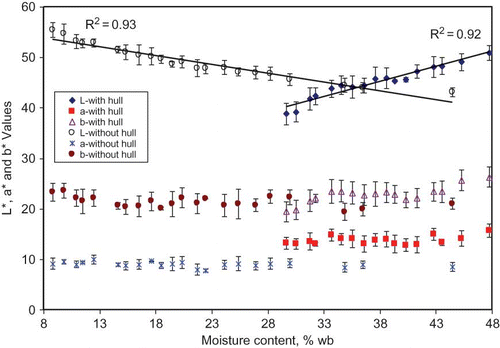
Figure 3 Relationship between color indices and MC for untreated Howard walnuts with and without hulls at second harvest. (Color figure available online.)
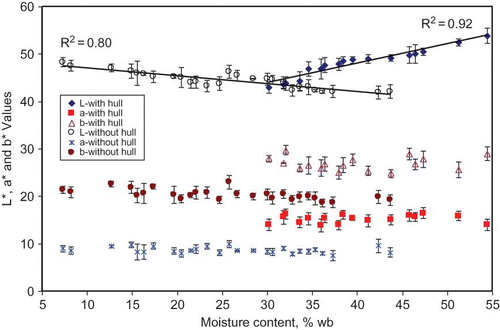
Figure 4 Relationship between color indices and MC for ethephon treated Chandler walnuts with and without hulls at first harvest. (Color figure available online.)
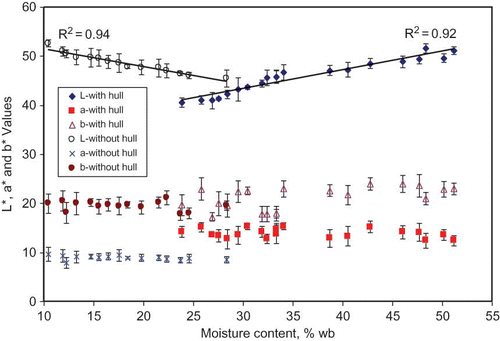
Figure 5 Relationship between color indices and MC for untreated Chandler walnuts without hulls at first harvest. (Color figure available online.)

The obtained results demonstrated that the L* value which represents the brightness generally decreased as the MC increased for walnuts without hulls. These results have a similar trend as those reported by Altuntas[Citation1] for walnut without hull at harvest. Özkan et al.[Citation28] found that the surface color characteristics of apricots changed as a result of moisture level change. In contrast, for walnuts with hulls the L* value increased as the MC increased in this study. This trend was also observed for all tested varieties. The change in L* value may be attributed to the change in the spectral characteristics of light reflected from walnut surface. The wavelength of light reflected from walnut surface changed as the result of MC of walnut shells. For shells with high MC, the pores existing in the shells are filled with water molecules; this may affect the amount of reflected light. Consequently, the shell brightness increased with increase of MC of walnut with hulls. On the other hand, for walnut without hulls at harvest the increase of shell MC may result in adhesion of dry dirt clod on the walnut shell during harvesting process. This may make the shell color darker than the shell color of walnut with hulls at harvest. High correlations were found between shell moistures and L* values for all tested varieties under all tested conditions. Regression models were developed to describe the relationship between L* values and walnut MC ().
Table 3 Regression equations of MC of walnut and L Footnote* or ΔE value of walnuts with and without hulls at harvest
Color parameter a*
It is clear that the a* values did not change much with the change of MC within the same walnut category (–). However, the a* values of walnuts with hulls were higher than those of walnuts without hulls. This trend was observed for all tested varieties. For example, average a* values for walnuts without and with hulls were 8.08 ± 0.56 and 12.33 ± 0.73 for Tulare, 8.82 ± 0.57 and 14.48 ± 0.75 for Howard, and 8.93 ± 0.43 and 13.84 ± 0.96 for Chandler. The effect ethephon treatment and harvest time on a* values was not significant. On average, the a* values of the Howard variety with and without hulls were 8.96 ± 0.50, 13.74 ± 0.85 and 8.68 ± 0.63, 14.21 ± 0.86 for treated and untreated walnuts, respectively, which means that the walnuts with and without hulls could also be sorted based on their deference in color parameter a*.
Color parameter b*
In general, there was no clear distinction in the values of b* as the MC of walnut varied from low to high for walnuts with and without hulls (–). This phenomenon is referred to as interference of color values. For example, the b* values of Tulare varied from 16.0 to 21.3 with the change of MC from 10.35 to 33.41%. Similarly, the b* values also varied from 16.6 to 21.9 with the change of MC from 26.85 to 46.30% for walnuts without and with hulls, respectively (). A similar trend was observed for Howard and Chandler varieties (–). The results indicated that the b* value (yellowness indicator) was not affected by the MC of walnuts regardless with and without hulls. Therefore, color parameter b* was insufficient to represent the MC difference for walnuts. These results are in agreement with those reported by Altuntas[Citation1] for walnuts without hulls.
Total color difference ΔE
The total color difference (ΔE) values at different MCs of walnuts with and without hulls for tested varieties are shown in and . It is clear that ΔE values were affected by the MC for all tested walnut varieties. For walnuts with hull, ΔE decreased with the increased MC. For example, the ΔE decreased from 63.8 to 52.2 when the MC increased from 27.45 to 45.66% for treated Tulare variety, and it decreased from 62.8 to 55.2 when the MC changed from 30.06 to 47.78% for treated Howard variety (). A similar trend was also observed for untreated Howard and treated Chandler varieties. The results indicate that the walnuts with hulls tend to get lighter as the MC increased due to increased amount of reflected light as previously discussed (section 3.2.1). In contrast, for walnuts without hull, ΔE increased with increased MC. For example, ΔE increased 8.8 units by increasing MC from 10.97 to 33.41% for treated Tulare, and it increased 9.6 units by increasing MC from 9.29 to 44.48% for treated Howard walnut varieties (). The same trends were observed for untreated Howard and treated and untreated Chandler. The changes of ΔE with MC of walnuts with and without hulls were linear and had high correlation coefficients for all tested varieties. The regression models of ΔE versus walnut MC were developed and showed high accuracy as listed in . The relationship of ΔE and MC could be used to develop walnut sorting devices in order to improve the current drying practices of walnuts. The color values can be easily transferred to industrial applications when the technology is scaled up.
Hue angle (h*) and chroma (C*)
In general, the hue angle and chroma relationships with MC were non-linear within the same categories of walnuts either with hulls or without hulls (). For all tested varieties at various conditions, the h* values for walnuts with hulls were lower than those of without hulls (–8c). For examples, average h* values for walnuts with and without hulls were 58.24 ± 1.90 and 66.41 ± 0.93 for treated Tulare, 59.11 ± 1.32 and 67.18 ± 1.10 for treated Howard, 60.54 ± 1.65 and 66.94 ± 0.56 for untreated Howard, and 56.81 ± 2.73 and 65.51 ± 0.88 for treated Chandler (). In contrast, the C* values for walnuts with hulls were higher than those of walnuts without hulls (–8c). The average C* values for walnuts with and without hulls were 23.59 ± 1.82 and 20.01 ± 1.81 for treated Tulare, 26.98 ± 1.93 and 22.99 ± 1.05 for treated Howard, 31.04 ± 1.41 and 22.23 ± 1.09 for untreated Howard, and 25.45 ± 1.78 and 21.49 ± 0.82 for treated Chandler (). The results indicated that both hue angle and chroma values could not precisely describe the change of color in relation to MC of walnut shells.
Table 4 Means and standard deviations of hue angle (h*) and chroma (C*) for tested walnut varieties at harvest
CONCLUSION
The research results showed that MC of walnuts with hulls at harvest was much higher than that of nuts without hull. The presence of hulls was a major factor affecting color characteristics of walnuts. Strong relationships between moisture and some color characteristics (L and ΔE) have been established. There is an interference or overlap among b* values for walnuts with and without hulls for all tested varieties. There was no clear relationship between a* value and the MC. However, the a* values of walnuts with hulls were higher than those of walnuts without hulls. The L* and total color difference (ΔE) value decreased with increased MC for walnuts without hulls and increased with the increase of MC for walnuts with hulls. The hue angle and chroma relationships with MC were non-linear for walnuts either with hulls or without hulls. The h* values for walnuts with hulls were lower than those of walnut without hulls. In contrast, the C* values for walnuts with hulls were higher than those without hulls. The relationships between the MC of walnuts and shell color characteristics of L and ΔE values can be used for scaling up to develop commercial sorter for all tested varieties at different harvesting times and conditions.
ACKNOWLEDGEMENTS
The authors wish to thank the California Walnut Board for its partial financial support, and Cilker Orchards for their generosity in supplying walnut samples used throughout this research. The research was conducted at the Western Regional Research Center of USDA-ARS and Department of Biological and Agricultural Engineering, University of California, Davis, California, USA.
REFERENCES
- Erkol , Altuntas, E. 2009 . M. The effect of moisture content on color characteristics of walnuts . International Journal of Food Engineering , 5 ( 2 ) : 1 – 9 .
- Kader , A.A. 2002 . Post harvest technology of horticultural crops , Oakland , CA : University of California, Agriculture and Natural Resources, Publication 3311 .
- Romas , D.E. 1998 . Walnut production manual , Oakland , California : University of California, Agriculture and Natural Resources, Publication 3373 .
- Khir , R. , Pan , Z. , Atungulu , G.G. , Thompson , J.F. and Shao , D. 2011 . Size and Moisture Distribution Characteristics of Walnuts and their Components. Food and Bioprocess Technology Published online on November 23 doi: 10.1007/s11947-011-0717-1
- Rumsey , T.R. and Thompson , J.F. 1984 . Ambient air drying of English walnuts . Transactions of the ASAE , 27 ( 3 ) : 942 – 945 .
- Thompson , J.F. and Grant , J.A. 1992 . New moisture meter could curb overdrying of walnuts . California Agriculture , 46 ( 2 ) : 31 – 34 .
- Rumsey , T. and Lu , Z. 1991 . High temperature walnut drying , Sacramento , CA : Walnut Marketing Board . Research report
- Thompson , J.F. , Stone , M.L. and Kranzler , G.A. 1985 . Modified air flow and temperature hop drying . Transactions of the ASAE , 28 ( 4 ) : 1297 – 1300 .
- Abe , T. and Afzal , T.M. 1997 . Thin layer infrared radiation drying of rough rice . Journal of Agricultural Engineering Research , 67 : 289 – 297 .
- Afzal , T.M. and Abe , T. 1998 . Diffusion in potato during far infrared radiation drying . Journal of Food Engineering , 37 : 353 – 365 .
- Afzal , T.M. and Abe , T. 2000 . Simulation of moisture changes in barley during far infrared radiation drying . Computers and Electronics in Agriculture , 26 ( 2 ) : 137 – 145 .
- Hebbar , H.U. and Rostagi , N.K. 2001 . Mass transfer during infrared drying of cashew kernel . Journal of Food Engineering , 47 : 1 – 5 .
- Khir , R. , Pan , Z. , Salim , A. , Hartsough , B.R. and Mohamed , S. 2011 . Moisture diffusivity of rough rice under infrared radiation drying . LWT-Food Science and Technology , 44 : 1126 – 1132 .
- Pan , Z. , Khir , R. , Godfrey , L.D. , Lewis , R. , Thompson , J.F. and Salim , A. 2008 . Feasibility of simultaneous rough rice drying and disinfestations by infrared radiation heating and rice milling quality . Journal of Food Engineering , 48 : 469 – 479 .
- Pan , Z. , Khir , R. , Bett-Garber , K.L. , Champagne , E.T. , Thompson , J.F. , Salim , A. , Hartsough , B.R. and Mohamed , S. 2011 . Drying characteristics and quality of rough rice under infrared radiation heating . Transactions of ASABE , 54 ( 1 ) : 203 – 210 .
- Brooker , D.B. , Bakker-Arkema , F.W. and Hall , C.W. 1992 . Drying and Storage of Cereals and Oilseeds , Westport , CT : AVI Publishing Co. .
- Lowe , E. , Rockland , L.B. and Yanase , K. 1961 . “ Studies on English walnuts ” . In Juglands regia. IV. Food Technology 116 – 117.19 . March
- Chen , P. 1978 . Use of optical properties of food and materials in quality evaluation and materials sorting . Journal of Food Process Engineering , 2 : 307 – 322 .
- Douglas , B.M. 2002 . Colour in food, improving quality , CRC Press LLC: Florida, USA .
- Mohsenin , N.N. 1984 . Electromagnetic radiation properties of foods and agricultural products , New York , NY : Gordon and Breach Science Publishers .
- Bulley , N.R. 1973 . Electronic color sorting of strawberries . Canadian Agricultural Engineering , 15 ( 2 ) : 103 – 106 .
- Houston , R.K. and Electronic sorting of apples, colorscan design and field experience. Cited in Mohsenin , N.N. 1984 . Electromagnetic radiation properties of foods and agricultural products , New York : Gordon and Breach Science Publishers, NW . 1962
- Powers , J.B. , Gunn , J.T. and Jacob , F.C. 1953 . Electronic sorting of fruits and vegetables . Agricultural Engineering , 34 ( 3 ) : 149 – 154 .
- Cammarn , S.R. , Lange , T.J. and Beckett , G.D. 1990 . Continunous fluidized-bed roasting . Chemical Engineering Progress , 40 : 46
- Driscoll , R.H. and Madamba , P.S. 1994 . Modeling the browning kinetics of garlic . Food Australia , 46 : 66 – 71 .
- Gary , K. and Gerhard , D.J. September 11 1992 . “ A versatile color system capable of fruit sorting and accurate object classification ” . In Proceedings of the South African Symposium (COMSIG) September 11 , 145 – 148 .
- Yildiz , H. and Baysal , T. 2007 . Color and lycopene content of tomato puree affected by electroplasmolysis . International Journal of Food Properties , 10 : 489 – 495 .
- Özkan , M. , Kirca , A. and Cemeroglu , B. 2003 . Effect of moisture content on CIE color values in dried apricots . European Food Research and Technology , 216 : 217 – 219 .
- Zielinska , M. and Markowski , M. 2011 . Color characteristics of carrots: Effect of drying and rehydration . International Journal of Food Properties , 15 : 450 – 466 .
- Moss , J.R. and Otten , L. 1989 . A relationship between color development and moisture content during roasting of peanut . Canadian Institute of Food Science and Technology Journal , 22 : 34 – 39 .
- Papadakis , S.E. , Abdul-Malek , S. , Kamdem , R.E. and Yam , K.L. 2000 . A versatile and inexpensive technique for measuring color of foods . Food Technology , 54 ( 12 ) : 48 – 51 .
- Salvador , A. , Sanz , T. and Fiszman , S.M. 2007 . Changes in color and texture and their relationship with eating quality during storage of two different dessert bananas . Postharvest Biology and Technology , 43 : 319 – 325 .
- Bernalte , M.J. , Sabio , E. , Hernandez , M.T. and Gervasini , C. 2003 . Influence of storage delay on quality of “Van” sweet cherry . Postharvest Biology and Technology , 28 : 303 – 312 .

